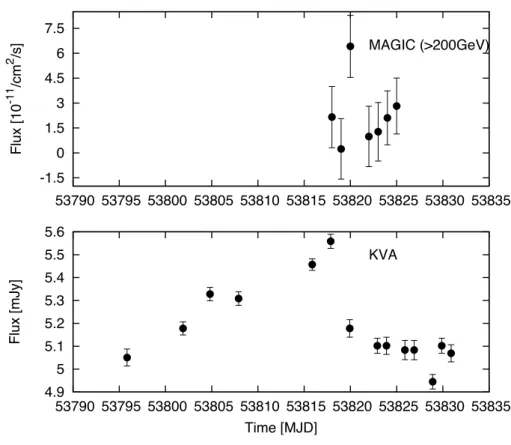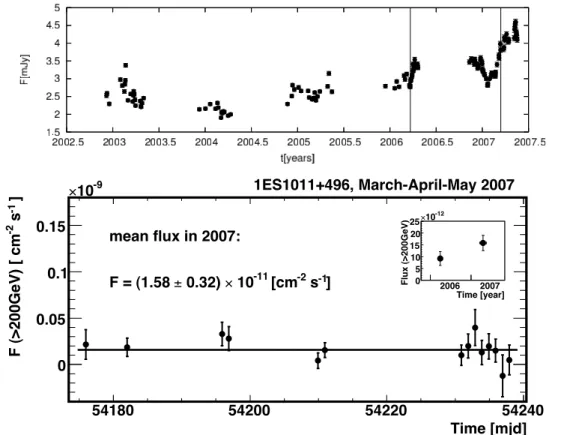Observations with the MAGIC Telescope
Elina J. Lindfors
∗†Tuorla Observatory, University of Turku E-mail: elilin@utu.fi
Daniel Mazin
Institut de Fisica d’Altes Energies (IFAE), Barcelona, Spain E-mail: mazin@ifae.es
Kari Nilsson
Tuorla Observatory, University of Turku E-mail: kani@utu.fi
Leo Takalo
Tuorla Observatory, University of Turku E-mail: takalo@utu.fi
The MAGIC collaboration has been performing Target of Opportunity observations of blazars, when seen flaring in optical by Tuorla blazar monitoring program. In past three years, there has been 5 optical alerts during good weather conditions and reasonable declination of the source.
Three alerts have resulted in discovery of VHE gamma-rays from previously undetected source.
We will introduce the Tuorla Blazar monitoring program and discuss the successful ToO obser- vations.
Workshop on Blazar Variability across the Electromagnetic Spectrum April 22-25 2008
Palaiseau, France
∗
Speaker.
†
on behalf of the MAGIC Collaboration
1. Introduction
MAGIC is an Imaging Air Cerenkov Telescope (IACT) located on La Palma, Canary Islands.
Due to its large collecting area and uniquely designed camera MAGIC has reached a lower en- ergy threshold (trigger threshold 50-60 GeV) for gamma-ray emission than any existing terrestial imaging gamma-ray telescope.
Blazars are the most extreme types of Active Galactic Nuclei (AGN). In these objects the dominant radiation component originates in a relativistic jet pointed nearly towards the observer.
Blazars show variable flux in all wave bands from radio to very high energy (VHE, defined as E > 100 GeV) γ -rays. The relationship between the variability at different wave bands appears rather complicated. The MAGIC collaboration is performing Target of Opportunity observations of sources in high flux state in the optical and/or X-ray band. Alerts of optical high state originate from Tuorla Blazar Monitoring Program. Optically triggered observations have resulted in discovery of VHE γ -rays from Mrk 180 [1] and 1ES 1011+496 [2]. During the workshop we triggered observations of S5 0716+714 which resulted in the discovery of VHE γ -rays from S5 0716+714 [3] . In this paper we describe the Tuorla Blazar monitoring program and present results of the optically triggered ToO observations with the MAGIC telescope.
2. Tuorla Blazar Monitoring Program
The optical monitoring observations are performed with the KVA 35 cm telescope, which is remotely operated from Finland and the Tuorla 1m telescope. The observations are done in the R-band and the magnitudes are measured using differential photometry with calibration stars in the same CCD frame as the object. The light curves are updated to project web page http://users.utu.fi/kani/1m/
on daily basis.
The long term monitoring program consists of 24 objects, which were chosen from a list of candidate TeV blazars by Costamante & Ghisellini (2002)[4]. The monitoring started in 2002 with the goalto study the optical variability of these sources and to determine the baseline flux. We have also made a study of the host galaxy contribution to the objects overall brightness [5]. This way we can get direct measurement of the AGN core brightness by subtracting the host galaxy distribution.
The collected lightcurves have been used to study the variability characteristics of these blazars [6] and to define the trigger criteria for Target-of-Opportunity program. As the ToO program has proved to be successful, we have added ∼ 20 more blazars to the monitoring program.
3. Optically triggered Target-of-Opportunity observations with MAGIC
Optically triggered ToO observations have resulted in discovery of three new Very High En- ergy γ-ray emitting blazars: Mrk 180 [1], 1ES1011+496 [2] and S5 0716+714 [3].
3.1 Mrk 180
Mrk 180 (1ES 1133+704) is a well-known high frequency peaked BL Lac (HBL) at a redshift
of z = 0 . 045 [7]. In March 2006 it underwent an optical outburst and was observed for 12.4 hours by
MAGIC. During these observations VHE γ -ray emission was detected with a significance of 5.5 σ .
4.9 5 5.1 5.2 5.3 5.4 5.5 5.6
53790 53795 53800 53805 53810 53815 53820 53825 53830 53835
Flux [mJy]
Time [MJD]
KVA -1.5
0 1.5 3 4.5 6 7.5
53790 53795 53800 53805 53810 53815 53820 53825 53830 53835
Flux [10
-11/cm
2/s] MAGIC (>200GeV)
Figure 1: Optical and VHE gamma-ray light curves of Mrk 180 from March 2006.
An integral flux above 200 GeV of (2 . 3 ± 0 . 7 × 10
−11) cm
−2s
−1was measured, corresponding to 11% of the Crab Nebula flux. No significant flux variation was found. Earlier observations by other experiments have only set upper limits on the VHE γ-ray emission from Mrk 180. The upper limits are above the flux measured by MAGIC. It is therefore not possible to judge whether the detected VHE flux level represents a flaring or a quiescent state of the AGN.
3.2 1ES 1011+496
1ES 1011+496 is a HBL object at a redshift of z = 0 . 212. The MAGIC observations were triggered by an optical outburst in March 2007 and the source was observed from March to May 2007. The 18.7 hours of data show an excess at 6.2 σ significance with an integrated flux above 200GeV of (1.58 ± 0 . 32) × 10
−11cm
−2s
−1. The source has been observed previously by MAGIC in March–April 2006 when the source was in a lower optical state. Those observations only showed weak evidence for a signal at 3 . 5 σ [8]. Consequently, the VHE γ -ray flux was > 40% higher in March–May 2007 than in March–April 2006, indicating that the VHE emission state may be related to the optical emission state.
3.3 S5 0716+714
The BL Lac object S5 0716+714 has been studied intensively at all frequency bands. It is
highly variable with rapid variations observed from radio to X-ray bands [9]. It has therefore been
Time [mjd]
54180 54200 54220 54240
]
-1s
-2F (>200GeV) [ cm
0 0.05 0.1 0.15
10
-9× 1ES1011+496, March-April-May 2007
mean flux in 2007:
-1
]
-2
s
-11
[cm
× 10 0.32) F = (1.58 ±
Time [year]
Flux (>200GeV) 0 5 10 15 20 25
10-12
×
2006 2007
Figure 2: Optical (top) and VHE γ -ray (bottom) light curves of 1ES 1011+496. The optical lightcurve shows 5 years of data from Tuorla blazar monitoring program and the vertical lines indicate the starting points of the MAGIC observations. The VHE γ -ray lightcurve shows two months of data from 17th of March to 18th of May 2007. The inset shows the yearly averages.
target to several multiwavelength campaigns, the most recent one organized by GLAST-AGILE Support Program in July-November 2007 [10, 11]. Due to the very bright nucleus which outshines the host galaxy, its redshift is still uncertain. The recent detection of the host galaxy [12] suggests a redshift of 0 . 31 ± 0 . 08 which is consistent with the redshift z=0.26 determined by spectroscopy for 3 galaxies close to S5 0716+714 [13, 14]. It can therefore be concluded that 0.26 seems to be a rather likely redshift for S5 0716+714, although with the lack of lines in the optical spectrum [15, 16], the ultimate proof for the redshift is still missing. S5 0716+714 has a synchrotron peak at optical band and is therefore classified as LBL [17] or IBL [18]. The discovery of S5 0716+714 by MAGIC represents only the third LBL (BL Lac[19]; W Comae[20]) that has been detected at VHE γ-rays. With a presumable redshift of z=0.26, S5 0716+714 is the most distant object of the three.
In April 2008 the optical flux of S5 0716+714 almost doubled in three nights (14th of April:
29 mJy, 17th April: 52 mJy) reaching its historical maximum on April 17th. MAGIC started the
observations 5 nights later (22nd), when the moon conditions allowed. The observations resulted
in the discovery of VHE γ-rays from S5 0716+714, announced with an Astronomer Telegram on
30th of April [3]. A detailed paper on the MAGIC results is in preparation.
0 10 20 30 40 50 60 70
2004 2005 2006 2007 2008
Flux [mJy]
Time [years]
0 10 20 30 40 50 60 70
2004 2005 2006 2007 2008
Flux [mJy]
Time [years]
20 40 60
14 18 22 26 30
Flux [mJy]
day of April 2008 20
40 60
14 18 22 26 30
Flux [mJy]
day of April 2008
Figure 3: Long term optical lightcurve of S5 0716+714. The inset shows the lightcurve from April 2008, the pink datapoints are simultaneous with MAGIC observations.
−14
−13
−12
−11
−10
−9
10 15 20 25
log10(νFν[erg/cm2/sec])
log10(ν[Hz]) Metsähovi
KVA
SWIFT
MAGIC


![Figure 4: The spectral energy distribution of S5 0716+714. The black data are the historical SED from [21]](https://thumb-eu.123doks.com/thumbv2/1library_info/4010658.1541101/5.892.174.706.611.985/figure-spectral-energy-distribution-black-data-historical-sed.webp)